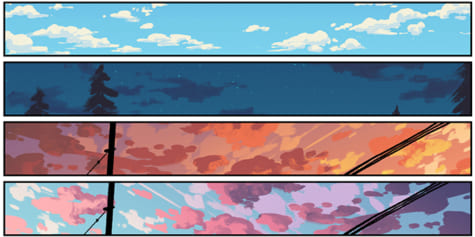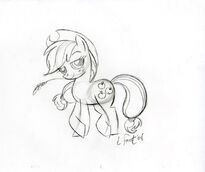Perspective, or the change in size and shape of objects as they recede toward the horizon, has a big role in drawing skies. You can not just draw distant clouds as smaller versions of clouds that are close to you. In the diagram at the right, you see a procession of differently sized ellipses in the sky, receding into the distance. Note how the ones at the bottom (closer to the horizon) are more squashed than the ones at the top (closer to you). Distant shapes are distorted to thin horizontal elements while objects overhead maintain their true shape. If a cumulus cloud passes overhead, you see its irregular edges. It will not show the classic billowy shape of a cumulus cloud because you are looking at the bottom. Similarly, if there is a hole in the cloud layer overhead, you will see the irregular shape of the hole. If you look at a distant cumulus cloud, its dark bottom is foreshortened to a horizontal ellipse. What you see of the cloud is now mostly a side view. Holes in a distant clouds are also distorted to horizontal linear blue areas. In between those two extremes, the clouds show some bottom and some side.
In this painting, note how the blue sky holes near the top are more open or closer to circular. Those closer to the horizon are more linear. Also observe that the shadow of the cloud at the top covers most of the observed surface of the cloud while distant cloud shadows are more linear and horizontal. Keep these relationships in mind as you sketch your skies.
Let’s look at a step by step approach to drawing a cloudscape with colored pencils. Here I blocked in the shape of cumulus clouds with a blue pencil. I have overlapped several layers of clouds with closer spacing toward the horizon.
Cumulus clouds often have flat bases at a consistent height across the sky. This is caused by the temperature threshold in the air called the dew point. Above this point is cold enough for water vapor (invisible gas) to condense into tiny droplets of liquid water that form the cloud we see.
To suggest the flat bottoms of the clouds I shaded the bottoms of the clouds with lines converging toward a vanishing point below the horizon. The thickness of these cloud bottoms gets smaller toward the bottom and eventually merges into a continuous layer in the deep background. This is one point perspective and it gives the suggestion of the plane of the sky receding into the distance.
Clouds appear white because of the contrast of the dark blue adjacent to them. I gave value to the sky with strokes that also converge toward the vanishing point, reinforcing the idea of the plane of the sky and deep space. Because the sky plane if farther away than the clouds, the vanishing point for the sky is slightly higher than that used for the clouds.






